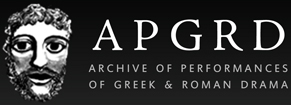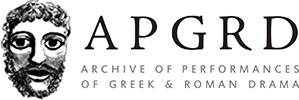The Archive in 100 Objects
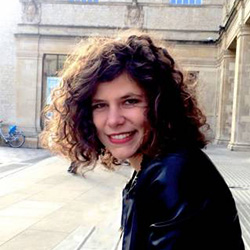 In this series, researchers explore the larger stories told by single objects in the archive. Here, Dr Giovanna Di Martino (APGRD early career associate) explores what Leopoldo Metlicovitz's poster can tell us about the production that it advertises - a performance of Aeschylus' Agamemnon at the Greek theatre of Syracuse in Sicily in 1914.
In this series, researchers explore the larger stories told by single objects in the archive. Here, Dr Giovanna Di Martino (APGRD early career associate) explores what Leopoldo Metlicovitz's poster can tell us about the production that it advertises - a performance of Aeschylus' Agamemnon at the Greek theatre of Syracuse in Sicily in 1914.
This blog post has an accompanying podcast episode featuring Oliver Taplin and Giovanna Di Martino
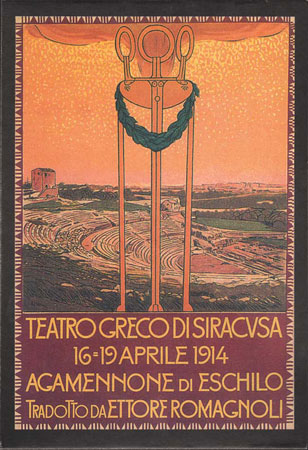
It was 16 April 1914 at sunset, when a company of around one hundred people - actors, musicians and dancers - mounted the stage of the Greek theatre of Syracuse in Sicily. The theatre was 2,500 years old, and they had assembled to perform a tragedy equally old, Aeschylus’ Agamemnon, as Leopoldo Metlicovitz’s poster indicates. The image of a three-legged tripod dominates the foreground. This is a representation of the Delphic tripod, used as a seat from which the Pythian priestess was said to deliver her divine oracles. A laurel wreath hangs down from the tripod, which according to the myth meant that the seat had been left unoccupied by the priestess.
Why was the seat sacred to Apollo left empty by Metlicovitz? Perhaps the priestess had deliberately freed up her seat to allow the actors to ‘prophesy’ as part of their performance in her stead. And as with prophecy, their performance in the 1914 version of Aeschylus’ tragedy did not only look back to Aeschylus’ Agamemnon in a unique way; it also looked forward, as the production represented one of the earliest modern versions of the play in Italy, and inaugurated a festival that is now well over one hundred years old, indeed the longest running modern festival of ancient drama. Every year, between May and July, spectators from all over Italy still gather in the ancient Greek theatre at Syracuse to watch a Greek tragedy or a comedy at sunset (two Greek tragedies alternate in May and June, whilst one Greek comedy runs for two weeks in July).
Indeed, the explicit aim of the organising committee for the 1914 Syracuse festival was to establish a tradition that could resemble, in spirit and form, the festival of the ‘City Dionysia’ held in Athens every year during the fifth century BCE (see: An introduction to... ancient Greek theatre). At this ancient festival, trilogies of tragic plays were performed in sequence over a full day, each followed by a satyr play. What better play to inaugurate their new dramatic festival than Aeschylus’ Agamemnon, the first play in the only extant trilogy, the Oresteia (458BCE)? And what better playwright to choose for a Sicilian theatre than Aeschylus? Aeschylus, after all, had staged a play in this very theatre.
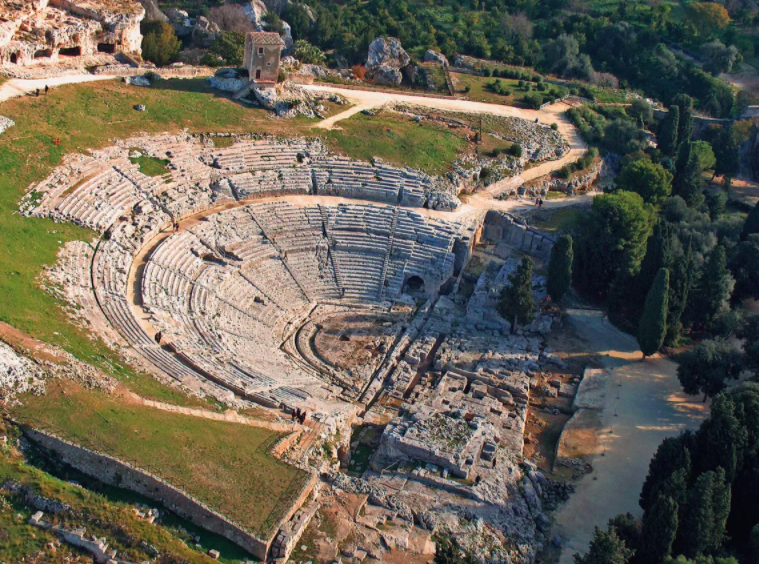
Right: View of the Greek theatre at Syracuse. Image from Wikimedia commons CC-BY-SA 2.0.
The 1914 Agamemnon was much concerned with archaeologically reproducing an Agamemnon as close to the ancient production as possible, and transporting the audience back into the fifth century. Twenty-four performers formed the chorus of old men, dancing and singing newly composed pieces of music: an introductory song dominated by the sound of the harp; a prelude, composed of wind instruments and a string quartet; a rather obscure piece accompanying the Chorus’ prayer to Zeus; a monody for Cassandra’s frenzy; and, finally, a funeral dirge sung by all actors to close the tragedy. Duilio Cambellotti’s scenery along with Bruno Puozzo’s costumes brought to life the archaeological discoveries by Heinrich Schliemann in his excavations at Mycenae, the ancient city of which Agamemnon was believed to be the king.
The set was made up of a faithful reproduction of the Lion Gate at Mycenae and a 13-meter-high tower on the top of which the watchman sat, dog-like, to catch sight of the beacon announcing the capture of Troy. Aeschylus’ Agamemnon (along with the Oresteia) would forever be the founding play of the Syracuse Festival, regularly reprised to celebrate the festival’s anniversaries or to signal particularly important events.
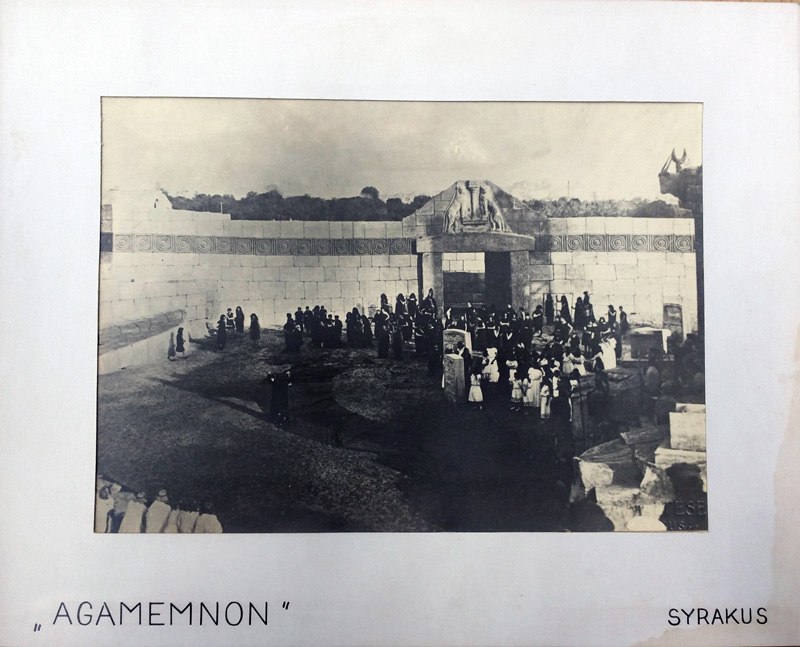 Right: The set of the 1914 Agamemnon at Siracusa. Leyhausen-Spiess collection, APGRD.
Right: The set of the 1914 Agamemnon at Siracusa. Leyhausen-Spiess collection, APGRD.
The empty Delphic tripod that adorns the poster, however, has another meaning in the context of this production. The priestess’ very absence could be said to ‘prophesy’ the plot of the play that unfolds. The absence of Agamemnon during his ten years at Troy has unleashed this most recent wave in the cycle of revenge that dominates the House of Atreus and which will end only in the Eumenides, the final play of the trilogy.
In this first play of the Oresteia, it is Clytemnestra who dominates the stage: a woman whose heart “is steeled by a man’s resolve”, according to the watchman; a woman who speaks “wisely, like a man of sense”, the chorus concur. And by the end of the play, Clytemnestra will have divested herself of the conventional female traits of a Greek woman and acquired that masculinity that the other characters have attributed to her throughout the play. She is in control, not a wife to a ruler, but a murderer, dissembler and leader of a palace coup.
The Syracuse Festival had revolutionary beginnings. Not only did the play’s emphasis on male absence and female presence make it a revolutionary choice in patriarchal early twentieth-century Italy; it was equally revolutionary to stage a play about the absence caused by war in 1914 on the eve of World War I. Whilst a fair number of Italians (and not only Italians) were keen to glorify war, militarism and patriotism, the organising committee of the Syracuse Festival were strongly opposing such jingoism in their production. Their international appeal to anti-war sentiments was hugely popular. More than seven thousand spectators came from all over the world: Italy, England, France, Germany, Belgium, Netherlands and even America, as newspaper articles testify.
However, this sense of internationalism generated in the theatre at Syracuse in 1914 could not withstand the rising tide of Fascism in the post-war world, when Mussolini saw in the Festival the political and cultural potential to promote a strong national identity. Were the 1914 organising committee, the theatre company and all seven thousand spectators aware at that time just how much they were shaping history? Probably not. But we can now recognise the production as a truly prophetic one.
The image of Metlicovitz's poster is used here by kind permission of the Archivio Fondazione INDA, Syracuse.
Find out more
- About Giovanna Di Martino
- INDA's 1914 production is discussed, alongside a wealth of other productions, in the APGRD's free interactive/multimedia iBook, Agamemnon, a performance history (EPUB for other devices to follow).
- For further reading, see the APGRD edited collection Agamemnon in Performance 458 BC to AD 2004, edited by F. Macintosh, P. Michelakis, E. Hall and O. Taplin (Oxford, 2005).
- You can also listen to an audio recording of playwright Rory Mullarkey and director Adele Thomas discussing some of the challenges involved in translating Aeschylus’ Oresteia for a modern audience (in 2015 at London’s Globe Theatre).
